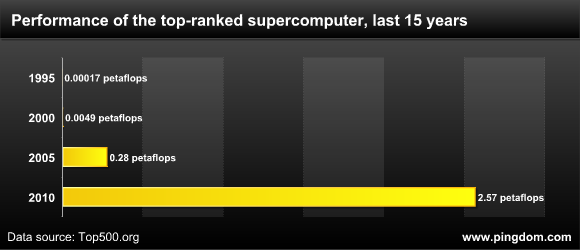
Computer hardware has become infinitely more powerful through the years, a trend that has allowed computer makers to push the performance to levels we almost thought were impossible just a decade earlier.
The exponential growth of computing performance is very noticeable when you examine how the performance of the world’s most powerful computer systems, the supercomputers, has changed over time.
To give you an idea of how rapidly performance has been growing, the top supercomputer in 2000 delivered more performance than the entire top 500 supercomputers combined in 1995, just five years earlier. Comparing 2005 with 2000 you see the same thing, and 2010 with 2005.
Top supercomputer performance over time
Here is the performance of the fastest supercomputer in the world, the past 15 years:
- Top in 2010: 2.57 petaflops
- Top in 2005: 280.6 teraflops
- Top in 2000: 4.94 teraflops
- Top in 1995: 170 gigaflops
If we set the fastest supercomputer in 1995 as the baseline:
- The top supercomputer in 2000 was 19 times faster.
- The top supercomputer in 2005 was 1,650 times faster.
- The top supercomputer in 2010 was 15,100 times faster.
Or, illustrated with a chart:

We could have used a logarithmic scale to make the smaller values easier to see, but we wanted to illustrate the sheer difference in scale. The bars for 1995 and 2000 aren’t even a pixel wide.
If you wonder why we didn’t go farther back than 1995, it’s because the TOP500 Project didn’t start tracking the global supercomputing performance until 1993.
From billions to trillions to quadrillions
In 2010, we measure the performance of the fastest supercomputers in petaflops (quadrillions of operations per second). In 1995, we used gigaflops (billions of operations per second). We are now using a scale a million times larger than we did 15 years ago.
That’s progress. 🙂
Top image: The Jaguar, the fastest supercomputer in the world until very recently. Image courtesy of the National Center for Computational Sciences, Oak Ridge National Laboratory.


























